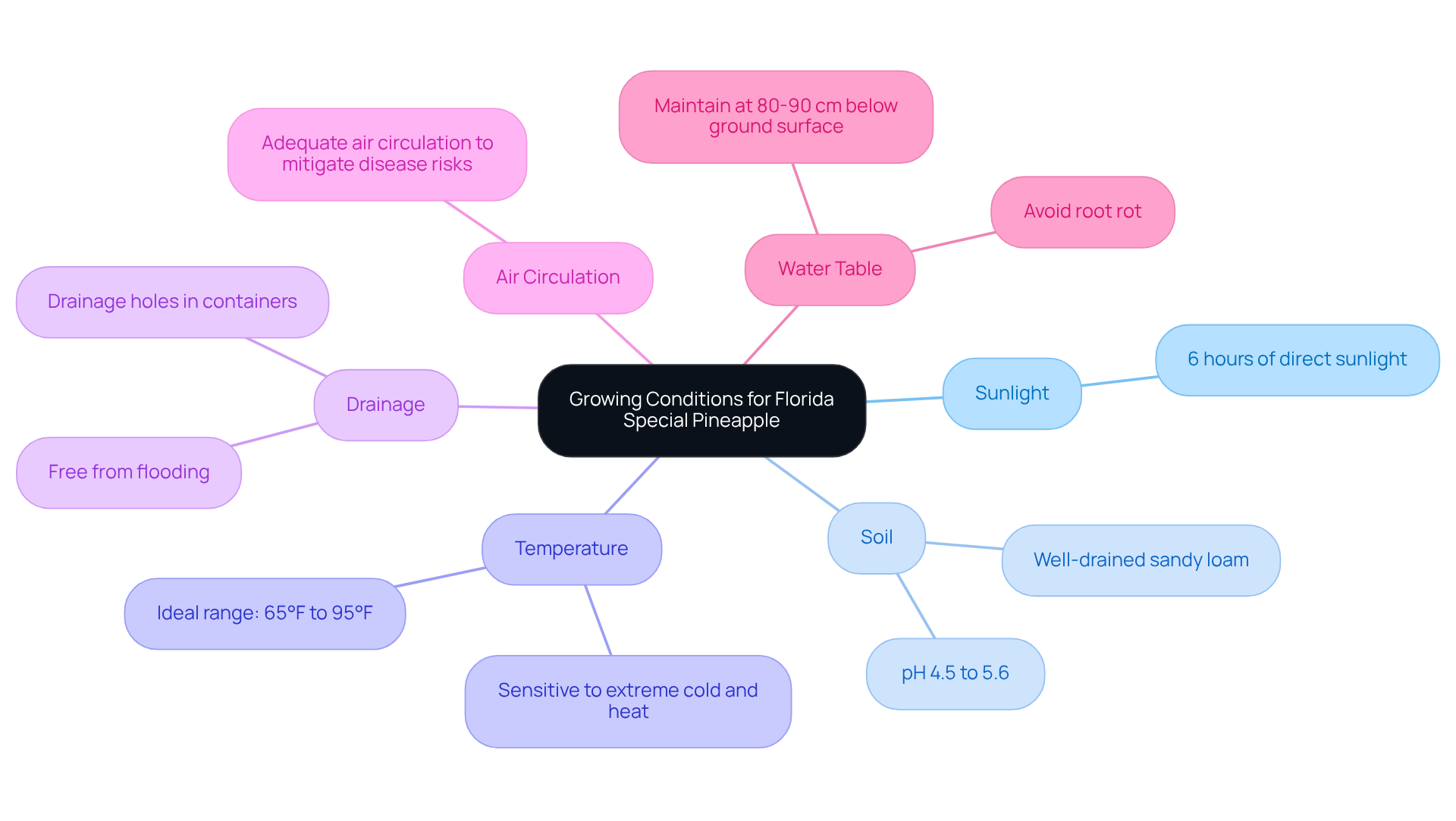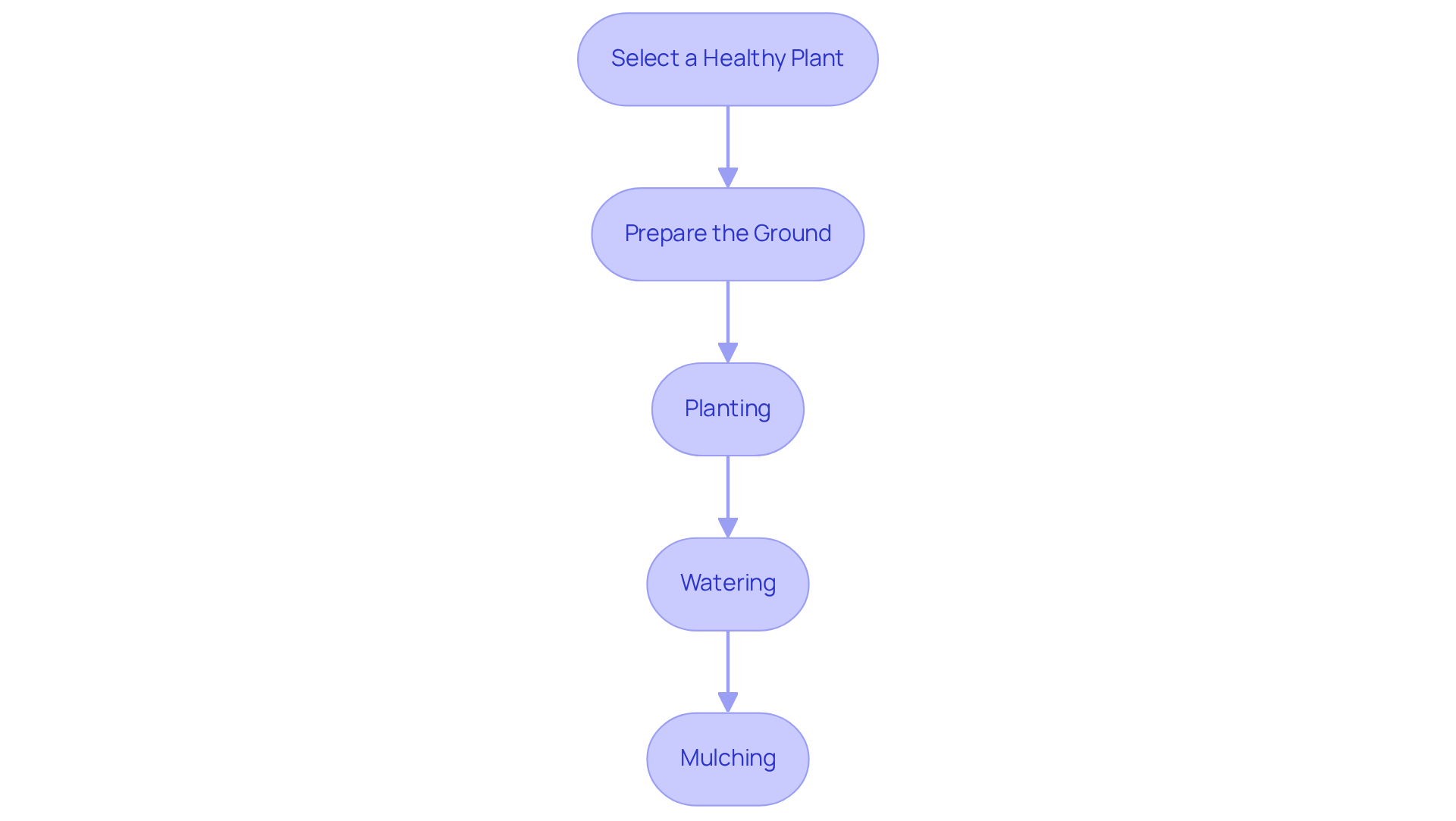
Master the Florida Special Pineapple Plant: Essential Steps for Success
Share
Cultivating the Florida Special Pineapple plant can be a rewarding endeavor, requiring a keen understanding of its unique needs.
Detailed guidance is provided on critical factors such as:
- Sunlight exposure
- Soil preparation
- Watering practices
- Fertilization
- Troubleshooting common issues
By equipping gardeners with this knowledge, the article aims to ensure healthy growth and fruitful production of this tropical fruit.
Thinking about growing a Pineapple Plant in your garden?
Explore the Florida Special Pineapple Plant at Everglades Farm - shipped directly from Florida.
1. Understand the Growing Conditions for Florida Special Pineapple
The Florida Special Pineapple plant flourishes in full sun, requiring at least six hours of direct sunlight daily. The Florida Special pineapple plant variety thrives in well-drained, sandy loam soil, ideally with a slightly acidic pH range of 4.5 to 5.6, which is crucial for nutrient availability. Ideal temperatures for the Florida Special pineapple plant's development range from 65°F to 95°F, as this plant is particularly sensitive to extreme cold and heat.
To encourage healthy growth, it is essential to ensure that the planting area is free from flooding and has adequate air circulation to mitigate disease risks. Proper ground preparation is vital for underground development, necessitating loose earth to a depth of no less than 2 feet to foster strong root expansion. For container gardening, select pots with drainage holes to prevent waterlogging, which can lead to plant decay.
Additionally, maintaining the water table at 80-90 cm beneath the ground surface is crucial for avoiding root rot and promoting healthy growth. When positioning soursop trees or passion fruit vines next to your pineapple crops, consider their similar growing conditions and sunlight requirements, and implement pest control methods such as regular checks and organic solutions to protect your tropical garden.

2. Plant Your Florida Special Pineapple: Step-by-Step Instructions
-
Select a Healthy Plant: Begin by choosing a healthy pineapple crown or a young plant from a reputable nursery. Look for vibrant green leaves and a firm base. If you're interested in passion fruit, opt for a vigorous vine variety that thrives in your local climate. This selection ensures a strong start for your gardening efforts.
-
Prepare the Ground: Amend the earth with organic matter, such as compost or well-rotted manure, to improve drainage and nutrient content. If using a pot, fill it with a well-draining potting mix, ideally designed for succulents or cacti. For passion fruit, ensure the ground is rich in nutrients and has a pH between 6.0 and 7.0 for optimal growth, setting the stage for healthy development.
-
Planting: Dig a hole that is three times the diameter of the root ball and twice as deep. Position the vegetation in the hole, ensuring the crown is above the earth line. Backfill with soil and gently compact it around the base. When planting passion fruit, consider providing a trellis or support structure, as these vines require vertical space to grow effectively.
-
Watering: After planting, water the plant thoroughly, allowing excess water to drain. Ensure the top inch of soil dries out between waterings to prevent overwatering. For passion fruit, maintain stable moisture, particularly during the flowering and fruiting phases, while preventing waterlogging to protect the plants.
-
Mulching: Apply a layer of organic mulch around the base to retain moisture and suppress weeds, but keep it away from the crown to avoid rot. Organic mulch not only enhances soil quality as it decomposes but also provides essential nutrients to the vegetation, supporting overall health.

3. Maintain Your Pineapple Plant: Watering, Fertilizing, and Pruning
-
Water your pineapple vegetation once a week, ensuring that the top inch of soil dries out between waterings to prevent root rot. During particularly dry periods or in the summer, you may need to increase the frequency to every other day. However, always avoid overly wet soil, as pineapple plants thrive in well-drained conditions.
-
Fertilizing: Apply a balanced fertilizer, such as NPK 10-10-10, every 6-8 weeks throughout the growing season. This approach provides essential nutrients that promote vigorous growth and enhance fruit production. Agronomists recommend conducting regular soil tests to customize fertilization according to your specific soil conditions, ensuring optimal nutrient availability for your Florida Special Pineapple plant.
-
Pruning: Regularly remove any dead or yellowing leaves to improve air circulation and minimize the risk of disease. Pruning should ideally occur in early spring, after the last frost, to encourage new growth and maintain plant health. Effective fertilization strategies, combined with proper pruning, can significantly enhance the vitality and yield of your pineapple plants.
4. Troubleshoot Common Issues in Pineapple Cultivation
Identifying and addressing common issues in pineapple cultivation is crucial for ensuring healthy growth and fruit production. Focusing on the following key areas can significantly enhance your success:
-
Overwatering: Yellowing leaves serve as a primary indicator of overwatering. To address this issue, ensure that the ground has good drainage and reduce the frequency of watering. It is essential to allow the top inch of soil to dry out before watering again to prevent root suffocation.
-
Pests: Vigilance against pests such as mealybugs and scale insects is necessary, as they can severely impact plant health. For effective treatment, apply insecticidal soap or neem oil, carefully following the package instructions to ensure thorough coverage and effectiveness.
-
Nutrient Deficiency: Stunted development may signal a nutrient deficiency. Conducting a soil test is advisable to assess nutrient levels, particularly nitrogen and potassium, which are vital for pineapple development. Adjust your fertilization regimen based on the test results to promote optimal growth.
-
Root Decay: If your pineapple foliage wilts despite adequate watering, it may be suffering from decay. To remedy this, carefully detach the specimen from its soil, trim away any affected roots, and repot it in fresh, well-draining soil to restore its health.
By monitoring these factors and implementing appropriate treatments, you can cultivate robust Florida special pineapple plants that thrive in the climate of Florida.
Conclusion
Mastering the cultivation of the Florida Special Pineapple plant requires a comprehensive understanding of its specific needs and adherence to essential steps for success. This guide offers valuable insights into optimal growing conditions, effective planting techniques, and ongoing maintenance strategies crucial for nurturing thriving pineapple plants.
Key aspects covered include the necessity of:
- Full sun exposure
- Well-drained sandy loam soil
- Careful watering practices to prevent root rot
Furthermore, regular:
- Fertilization
- Pruning
are vital for promoting healthy growth and enhancing fruit production. Addressing common issues, such as overwatering and pest infestations, equips gardeners with the knowledge needed to maintain robust plants.
Ultimately, cultivating the Florida Special Pineapple transcends mere step-by-step instructions; it involves fostering a thriving ecosystem that meets the plant's needs. By implementing these best practices and remaining vigilant against common cultivation challenges, gardeners can savor the rewarding experience of growing their own delicious pineapples. Embrace the journey of pineapple cultivation, and witness how your efforts yield sweet, tropical rewards.
Grow Your Own Sweet Florida Pineapples Today!
Start your gardening journey with Everglades Farm and cultivate delicious fruits right in your backyard.
Frequently Asked Questions
What are the sunlight requirements for Florida Special Pineapple?
The Florida Special Pineapple plant requires at least six hours of direct sunlight daily to thrive.
What type of soil is best for growing Florida Special Pineapple?
The plant thrives in well-drained, sandy loam soil with a slightly acidic pH range of 4.5 to 5.6, which is important for nutrient availability.
What are the ideal temperature conditions for Florida Special Pineapple?
Ideal temperatures for the Florida Special pineapple plant range from 65°F to 95°F, as it is sensitive to extreme cold and heat.
How can I ensure healthy growth of the Florida Special Pineapple?
To encourage healthy growth, ensure the planting area is free from flooding, has adequate air circulation, and prepare the ground by loosening the soil to a depth of at least 2 feet for strong root expansion.
What should I consider when container gardening Florida Special Pineapple?
When container gardening, select pots with drainage holes to prevent waterlogging, which can lead to plant decay.
How important is the water table for the Florida Special Pineapple?
Maintaining the water table at 80-90 cm beneath the ground surface is crucial to avoid root rot and promote healthy growth.
Can I plant other crops alongside Florida Special Pineapple?
Yes, you can plant soursop trees or passion fruit vines next to your pineapple crops, as they have similar growing conditions and sunlight requirements.
What pest control methods should I implement for a tropical garden with Florida Special Pineapple?
Implement regular checks and organic solutions for pest control to protect your tropical garden.


